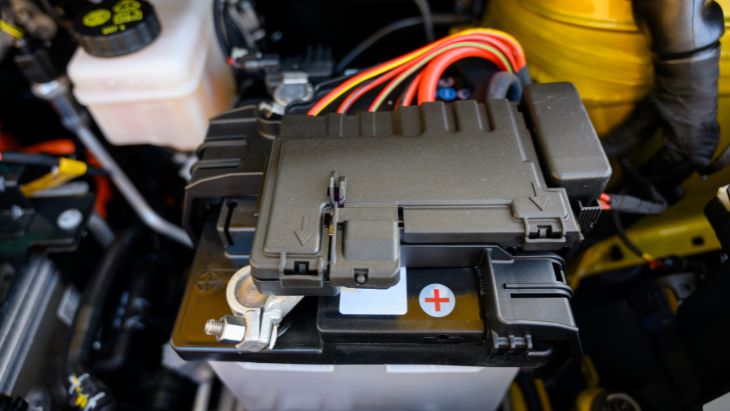A properly functioning car battery makes life easy. It gets the car started efficiently. You are not worried that your most important daily-use devices will run out of charge. Also, you are confident of a power source for your car audio system.
When you buy a new battery, you want it to serve you for the longest possible time. Most car batteries last 2 to 6 years, with the average age being around three and a half years.
What can you do to keep your battery rolling?
First, it’s important to understand the factors that influence the lifespan of a car battery. Weather conditions, maintenance, use, and vehicle type are among the most significant factors. Let’s look at some common reasons why batteries fail.
Why car batteries fail

Most battery failure incidents can be tracked to two main types of faults: manufacturing and non-manufacturing faults.
Manufacturing faults usually occur within 3 months after purchasing a new battery. They include:
- Dead cells – When one of the cells in a battery dies, it shows a considerably lower SG (Specific Gravity) reading compared to other cells.
- Internal break – This is mostly caused by physical damage, which mostly happens when the battery is being transported.
As an informed buyer, you have to check your new battery keenly or have it checked by an experienced technician, to make sure that none of these manufacturing faults are present. Also, buying from reputable and trustworthy battery manufacturers minimizes the chances of ending up with a battery that has a manufacturing fault.
Non-manufacturing faults occur months after the battery has been put to use. They are attributed to how the battery is used, or issues with the vehicle’s electrical system. These faults include:
- Wear and tear – This is an obvious consequence of the long-term use of a battery. A common sign of car battery wear and tear is the corrosion of the grid metal. Extensive wear and tear can strip a battery of its ability to start the vehicle engine. Noteworthy, high temperature accelerates the degradation of various parts of the battery.
- Physical damage – Improper handling, storage, or fitment can lead to damage to the battery’s exterior, which may result in subsequent failure.
- Wrong application – Using a battery that doesn’t fit the purpose is a possible cause of early battery failure. Relevant examples include using a less powerful battery than what’s required or using a battery designed for another purpose in a car.
- Sulphation – this occurs when a lead acid battery is left in a discharged state for an extended period.
- Negligence – one of the key maintenance measures required for car batteries is keeping electrolyte amounts at the correct levels. Failure to do this exposes the battery’s internal components, and this speeds up battery failure.
- Undercharging/overcharging – A car battery can get undercharged when the car is driven for short distances. It can also occur if the alternator is faulty, thus unable to charge the battery fully. Overcharging may also result from an incorrectly set alternator, alternator voltage control fails, or a malfunctioning component in the car’s charging system.
- Complete discharge – if lights or other car systems/accessories are left on for long periods, this may cause complete discharge of the car battery.
How weather influences car battery life
Weather is one of the most important factors affecting the lifespan of a car battery. It’s an appreciable fact that a running engine under the hood produces high levels of heat. Excessive heat can cause severe battery drain, which is why there are high chances of experiencing a dead battery if you driving under the hot sun without taking summer driving precautions.
Warm weather is not safe either. As long as the temperatures of the operating environment are high enough to cause the evaporation of battery fluid, you are looking at possible damage to the battery’s interior structure. Consequently, the average life of car batteries used in warmer climates is lower than that of batteries used in cooler areas.
Tips for extending car battery life

Understanding the causes of battery failure is the first step toward taking good care of the health of your car battery. The section above has taken you through this step.
Let’s now embark on useful tips on how to make your car battery last longer.
1. Secure fit
Vibration is a car battery’s number 1 enemy. It can cause damage due to abrasion and puncture, which are highly possible when driving on bumpy roads. Besides, vibrations can facilitate short-circuiting.
It’s not enough to have a sturdily-built battery clamp. Ensure that the battery is always fastened securely onto the clamp.
2. Keep dirt off the car battery
Dirt on top of the battery casing can drain the battery charge. Also, corrosion buildup (white powder around the terminals or clamps) can inhibit the flow of current.
Clean the battery terminals regularly with water, baking soda, and a nonmetallic brush. You don’t have to see signs of corrosion to know it’s time to clean the battery. Keeping it clean all the time will help to avoid corrosion in the first place.
Whenever you clean the battery, make sure you dry it thoroughly with a clean cloth. You can also apply a thin coat of high-temperature grease to battery posts and cable connections for extra protection against corrosion.
3. Keep the battery away from extreme temperatures
As previously noted, too cold and too hot operating environments can reduce a car battery’s life. Cold temperatures cause the battery to self-discharge, while extreme cold can cause the freezing of battery electrolytes.
Extreme heat can make battery fluid evaporate, leading to overcharging problems.
If you intend to keep your car unused over an extended period, make sure to store it in an environment with moderate temperatures.
And when using the car in hot environments, do anything that can keep the car cooler. One way is to have the battery insulated from the heat that the engine produces. Also, remember to park the vehicle under the shade whenever possible.
4. Avoid short, frequent trips
Driving to the corner store once in a while might not cause much harm to your battery. However, doing short trips frequently will shorten the lifespan of the battery.
It’s desirable for the battery to get fully charged every time the engine is turned on. A full charge requires about 8 hours of car use. If the battery isn’t charged fully crystalline deposits start to form on the negative plates. These deposits further limit the battery’s ability to obtain a full charge.
So, should you drive for at least 8 hours every time you start the car?
Or should I let the car idle for a few hours after an inevitable short ride?
Don’t idle your car as it has many negative effects on several components of the car’s electrical system. Specifically, idling the car causes the battery to strain. Idling doesn’t allow the battery to charge.
5. Turn off lights and auxiliary components when the car engine is off
Lights, car stereo, and the air conditioning system are heavy users of a car battery’s charge. They can put a heavy toll on your battery if left on while the car is not moving. Remember to turn the lights off whenever you exit the car. Also, turn off the air conditioner and the radio except when they are really needed.
6. Regular testing and inspection
Staying updated on the condition of your car battery helps to take necessary measures to maximize its life. Inspecting the battery regularly will keep you in the know about how well the battery is maintained.
You’ll need to test its output voltage level at least once a month. The aim is to make sure that the battery is not left partially or fully discharged for extended periods. The output voltage of a healthy battery is around 12.7 volts. Should you find the level to be below 12.5 volts, it’s recommended that you recharge it ASAP.
Note carefully that for a car battery, 12.4 volts means it’s half charged, and 12.0 volts means the battery is completely flat or dead.
7. Storage Tips
If you are planning to store your car for some months, you want to keep the battery alive all through the storage season. Naturally, all lead acid batteries self-discharge over time. Thus, the battery should be charged fully at least once every six weeks.
Many car owners are investing in a battery maintainer when they want to lock up their cars for several months. This appliance monitors the battery voltage and automatically adjusts the charge to avoid over- and under-charging.
Additional measures for extending the life of your car battery include:
- Keep the electrical system charging at the correct rate to prevent overcharging and undercharging.
- If your battery needs topping off, check the water levels regularly and add distilled water when appropriate.
- Every time you replace a battery, make sure that the new one is rated at least as high as the previous one.
- Make sure that other parts of the car are properly maintained. The battery of a well-running car is likely to last longer.
- If you are unsure about your car battery’s condition, let an expert inspect it and offer professional assistance and advice.
Also Read: Ultimate Guide on How to Connect Two Amps Together
You don’t have to wait for your car battery to start showing warning signs of ill health. Follow the tips above to avoid any kind of battery failure, and enjoy its service for the longest time possible. A healthy car battery is a comfortable driving life.
Michael Evanchuk is a San Francisco-based sound engineer with 20 years’ experience installing, troubleshooting, and repairing commercial, automotive, and household sound equipment. Evanchuk owns an auto stereo center, where he offers highly competitive car audio installation and repair services. He has written dozens of articles on different sound engineering topics, all of which have been published in leading journals, blogs, and websites.





